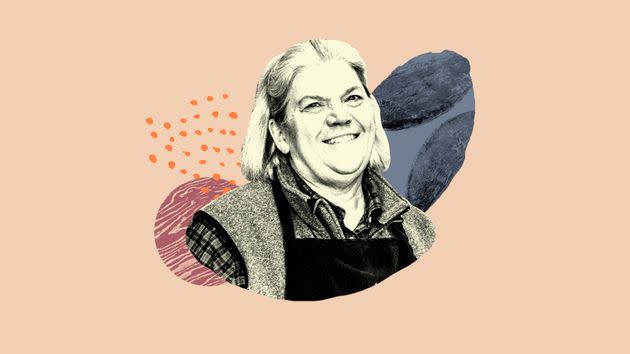The Face Of Hunger Isn't What It Used To Be

Nancy Lyons has been with Feeding Westchester for the past 25 years, currently serving as its director of volunteer services. The organization in New York state is part of Feeding America, a nationwide network of more than 200 food banks serving every state in the United States. The past year has seen a change in volunteer opportunities, as well as a greater awareness of the issues of hunger, the faces of hunger and what hunger represents in our society.
In this edition of Voices In Food, Lyons talks about how Feeding Westchester has been rising to the challenges of the increase in distribution and fewer on-site volunteers, how societal upheaval has impacted its mission, and the journey that she says she’s taking every day.
How the food distribution system has evolved over the years
Overall, there has been a slow shift in how hunger is addressed. The programs created to alleviate hunger used to be totally grassroots — somebody would notice people rummaging through garbage cans and bring them food, or a person would reach out to members of their faith to raise money for a family. The need grew and the tools became more sophisticated.
We now have nationwide organizations such as Feeding America and its tremendous capabilities. But as we’ve gained that sophistication, we must never lose track of compassion. We also try to provide an education about the work we do here. Where we used to hear, “There are starving children in other countries,” there’s now also a much more insidious form of hunger. It doesn’t equate with starvation but it takes over almost every aspect of someone’s daily life. It’s the senior worrying about making food last and using the same tea bag for three days. It’s the parents not eating with their children. It’s the people working at jobs not paying them a respectful wage.
How volunteering appeals to people from all walks of life
People of all ages and all walks of life volunteer. We have corporate employees, sports teams, students fulfilling community service requirements, court-appointed volunteers, retirees, etc. — it really runs the gamut. Pre-COVID we saw people with differing abilities eager to volunteer. Everyone has the right to be kind. While we are bringing people back on a very limited basis, we’ve also gotten creative on at-home volunteer opportunities. We created a “Help From Home” project where people can pack bags and drop them off. We started a new tradition out of a necessity. It’s caused us to remember what anonymous charity, or serving the unseen guest, means and its importance.
People don’t walk around wearing a button declaring they’re hungry.
With social media, our team does an excellent job capturing that ongoing spirit of giving. Today’s donors are more curious as to where and how their donations are used; social media allows us to broaden the concept of community. It goes a long way to continuing relationships and credibility.
How the face of hunger has changed
People don’t walk around wearing a button declaring they’re hungry. Those of us who have been involved with hunger relief have known for some time how fragile the links are when it comes to food security. People who used to donate could no longer do so; they were looking at how much food they had in their cupboards. When you think of all the people in the hospitality industry or the arts, you see they lost their main source of income and, for many of them, their supplemental source of income as well. It really brought home the message that hunger isn’t necessarily other people; it can be us. It was a humbling and heartbreaking message for many to learn.
Hunger is a societal issue
Alleviating hunger is a justice issue. I think we all have to agree that food should be able to be accessed in socially acceptable and compassionate ways. We’ve all recently witnessed a great deal of societal upheaval and see the tenuous thread between helping and needing help. Hunger is not a definition but a condition, and we have to address some of the root causes of this condition. Hunger is part of larger issues such as mental health, housing and education. We have to take a more comprehensive, holistic approach to how we address the bigger picture.
What we can all do to help
Especially during this holiday season, when some people are fortunate enough to have full refrigerators and pantries and are able to share not only food but having guests, we all need to take a moment to think about those facing the opposite. I’ll never forget a woman I met years ago during the holidays. She reminded me that hunger takes away the pleasure of having people in your home. “I can have company again,” she said. Our shopping lists and our recipes are luxuries. It’s time to recapture that spirit of sharing that we so naturally have as children.
If you feel compelled to help, visit FeedingAmerica.org to learn about donation and volunteer opportunities.
This article originally appeared on HuffPost and has been updated.

 Yahoo Finance
Yahoo Finance 


